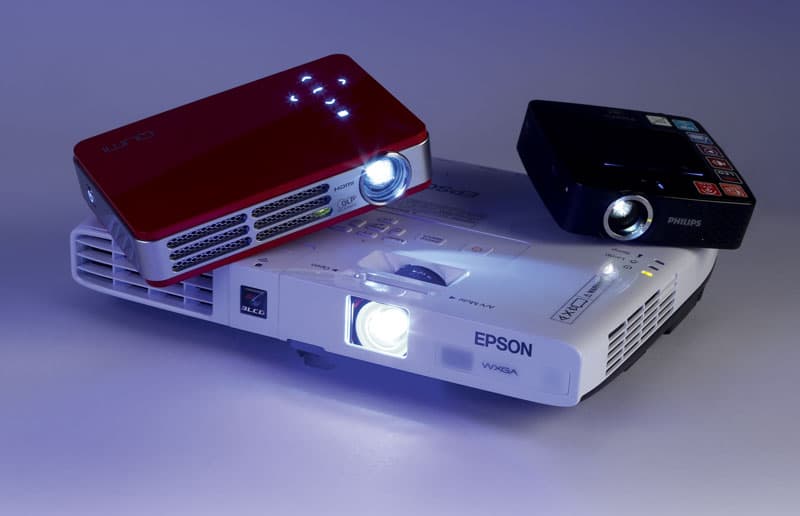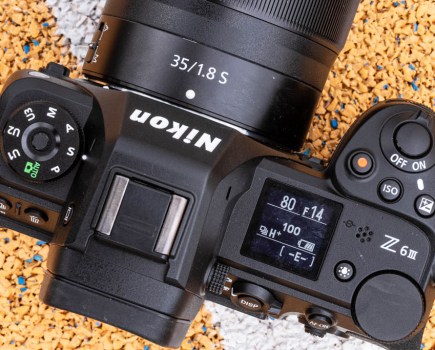Portable projectors are lightweight units that are small enough to fit in a satchel or even a shirt pocket, and can be used anywhere to instantly display your photographs and movie files.
As with most photographic equipment, the lens quality has to be good. The pocket projector’s lens will probably be a fixed focal length, which means you have to move the projector either closer or further away from the screen to reduce or enlarge the projected image.
Generally, the optimum viewing distance is 2-3 metres (6-9ft), which should produce an image size of 0.25-1.5m (10-60in). Bigger projectors usually incorporate a zoom lens, which enables the user to enlarge or decrease the image size without moving the projector.
Focusing is accomplished manually using a small wheel located near the lens. One problem with small projectors is that they need to be carefully aligned to the screen to avoid a keystone effect (this is when the image is distorted, giving the projected image a trapezoid shape), although more expensive projectors can automatically remove any keystone distortions. These small projectors also include a tripod socket at the base, which is useful when setting up.
Pocket projectors use LCOS (liquid crystal on silicon), laser or LED lights to deliver rich colours and still allow the projector to run cool. LED lamps have a life of approximately 20,000-30,000 hours. However, the downside of small lamps is that they often lack brightness, which can vary between 10 lumens and 200 lumens, with the higher lumens values producing a brighter display. The contrast ratio, which is a measure of the contrast between the brightest white and darkest black the projector can display, can also vary greatly. Higher ratios provide better pictures, especially in bright environments.
The resolution for most pocket projectors is 854×480 or 640×480 pixels, providing a screen aspect ratio of 16:9 or 4:3. This is fine for most viewing, including DVD playback, but will not do full justice to your 16-million-pixel image files. High-resolution full HD video files of 1280×720 and 1920×1080 pixels will be downscaled to the lower resolution. Projectors that have the highest contrast ratio, brightness and resolution will display the best picture quality.
As portable pocket projectors use a lithium battery, look for a projector model that has a removable battery so you can carry a spare one with you. A fully charged battery should last for approximately 90mins on a low-light setting or 45mins at maximum brightness. Some units can deliver a viewing time of 90-180mins, but this will generally be at a reduced brightness. Other power options include a mains adapter that you can use when viewing a feature film on DVD. Units that are iPhone compatible can also deliver power to an iPhone to provide a useful three hours of extra time, which is handy for the busy photographer on the move.

Image: Most portable projectors have a mini HDMI port, USB port and an SD memory card slot
Connections usually include a mini HDMI port that is used to connect a digital camera, camcorder or DVD/Blu-Ray player; a composite AV socket; a USB port for a cable or memory stick; and an SD memory card slot. Some projectors may also include internal memory, which can be used to store photographs or presentations. An audio-out port is used for connection to an external amplifier, powered speakers or headphones. Other connectivity options may include direct links to iPhone, iPad, iPod and other Android devices. Most popular file types should be supported, including JPEG, TIFF, GIF, PNG, BMP, AVI, MP4 and MOV. It is unlikely that raw files will be supported.
Depending on the software that comes with the projector, you may have an application that compiles photographs into a slide show with a variety of transition effects. Other applications may include a Microsoft Office document viewer that enables you to project PowerPoint presentations, Word and Excel documents. If linked to an iPad or computer, you can also browse the web. Projecting applications such as Photoshop, Lightroom and PaintShop Pro are useful for lectures and demonstrations.
Given that it’s a portable device, you are not going to get a concert-hall sound from a small projector with a small built-in speaker or speakers that have an output of 0.5-1.5 watts. At best, these will produce a similar sound quality to that obtained from a tablet device or phone. Projectors that incorporate an audio-out port can be connected to headphones or an external amplifier for a more dynamic sound quality.
The projector’s menu options should give sufficient control of brightness and contrast, plus adjustment on colour saturation. Other menu options may include a file directory for a memory card. Most projectors include an IR remote control, which is useful for controlling slide shows or pausing videos.
Finally, for the best viewing, you should use the projector in a dimly lit room together with a brilliant white screen. A good alternative is to use a large collapsible white reflector as a portable screen.








